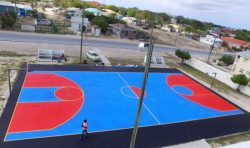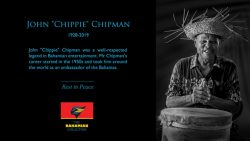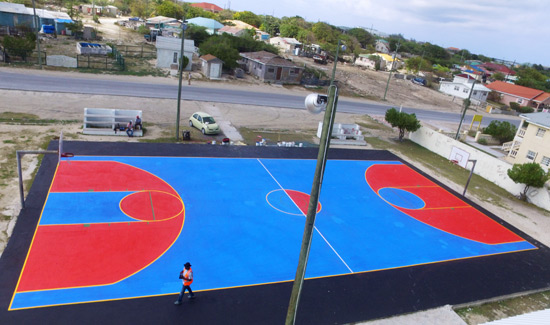
Bahamas Striping received tremendous validation of its work after securing and successfully completing its first regional assignment, a five-figure contract to mark seven miles of roads in Turks and Caicos.
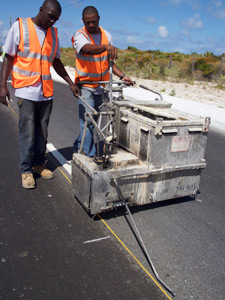 “Since establishing Bahamas Striping seven years ago my goal has always been to expand the company internationaly,” said Bahamas Striping’s president Atario Mitchell, a young tradesman with a string of entrepreneurial awards under his belt.
“Since establishing Bahamas Striping seven years ago my goal has always been to expand the company internationaly,” said Bahamas Striping’s president Atario Mitchell, a young tradesman with a string of entrepreneurial awards under his belt.
“This significant milestone gave me a great sense of Bahamian pride to obtain and execute our first international contract. We are definitely moving in the right direction,” he said. “As Bahamians, we don’t typically think of ourselves as exporters of technical skills. To witness our young Bahamian staff training Turks Islanders is truly a demonstration of what is possible.”
The work involved striping the reconstructed Lighthouse Road in Grand Turks. The company was contracted to stripe center lines, install reflective road studs, pedestrian crossings, school zones, rumble strips and bus stops markings and to serve as a consultant to the contractor.
Rhone Kelly’s Island Drilling was awarded the contract to upgrade the road to a modern standard with an asphalt cement surface contained by curbs, a sidewalk on one side and a cycle path on the other.
“To put the icing on the cake we said we needed professional stripers in here,” said Mr Kelly in explaining how he located his striping sub-contractors.
“The Bahamas Striping Group’s online visibility, reputation for international quality work and their commitment to community made them a good fit for our project so there was not even a second thought in terms of looking further north.”
He added: “My client, the Ministry of Works is extremely pleased and so are we. The quality and standard of the work goes beyond the highest international standard.”
Mr Mitchell led a team of four including his training manager, Brian Bostock and two young Bahamians neither of whom completed their high school education. Through the employment and empowerment opportunities afforded them by Bahamas Striping they were able to turn their life around as evident by this travel-to-train opportunity.
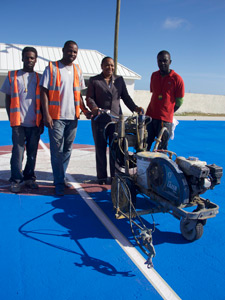 “This to me is the Bahamian dream,” said Mr Mitchell.
“This to me is the Bahamian dream,” said Mr Mitchell.
“While on the ground, two of our guys, a 19-year-old and a 23-year-old, were able to assist with training six residents of Turks Island, including a St Lucian and a Haitian national, in the striping business,” says Dominic Sturrup, Bahamas Striping’s senior vice president of business development.
The striping company has a track record of hiring marginalized men with few marketable skills and limited education who often go overlooked when it comes to employment opportunities.
“That gave our guys a great sense of pride, the knowledge transfer between them and the Turks Island residents who were much older,” said Mr Sturrup.
The striping project was carried out in two and a half weeks. A straightforward assignment, the only challenges were scattered days of inclement weather and getting the necessary equipment to the island. With no direct transportation by sea the company had to ship to Miami and from Miami to Grand Turks, a 15-day journey for their striping machinery.
Positive feedback
“We were pleasantly surprised to find our reputation preceded us,” said Mr Mitchell. “They knew about our quality of work, our employment track record, our philanthropic efforts with basketball courts makeovers and our Dollar That Could charitable initiative.”
The Bahamas Striping president likened the jurisdiction to “being back in The Bahamas.”
According to Foreign Affairs Minister Fred Mitchell, that’s only natural. Turks & Caicos was once historically considered a part of The Bahamas.
The minister traveled to Grand Turks to view Bahamas Striping’s work first-hand.
“They do a lot of good work in The Bahamas,” he acknowledged on the ground. “In the Caribbean context we have been talking a lot about spreading the expertise around. There is a lot of work in Haiti, projects in Jamaica and further south, so it’s good they started here in Turks and Caicos. They are our brothers. We are really one country.”
Also inspecting the striping work was the island’s first female premier, Bahamian-born Sharlene Cartwright Robinson.
“I’m very, very impressed with the work I see here,” said the leader of the People’s Democratic Movement. She welcomed the training provided to local residents and praised the company for providing a free, striping face-lift to a local basketball court.
Fifteen-year-old Omar Garland who regularly shoot hoops on the Overbeck Basketball Court said it was badly in need of repair. The makeover, he said, was a long time coming.
As a reputable, Bahamian company that stand behind its work, Mr Mitchell sees numerous business opportunities in Turks and Caicos.
“Having the opportunity to visit Grand Turk and Providenciales, we see lots of opportunities for us and other Bahamian companies,” he said. “The people were friendly and hospitable. We were truly blessed by our experience.”
Tosheena Robinson-Blair
Precision Media
Photos courtesy of Bahamas Striping
Top: Aerial of the Overbeck Basketball Court
Left: North Caicos resident Cameron Gardiner and Bahamas Striping President Atario Mitchell carry out work on the Lighthouse Road in Grand Turks.
Right: Turks and Caicos Islands’ Premier Sharon Cartwright-Robinson stripes her first line. She visited the site to view the Bahamian company’s work first hand. From left to right, Eleuthera’s Teiko Moss, Bahamas Striping’s President Atario Mitchell, Premier Robinson and North Caicos trainee Cameron Gardiner.

